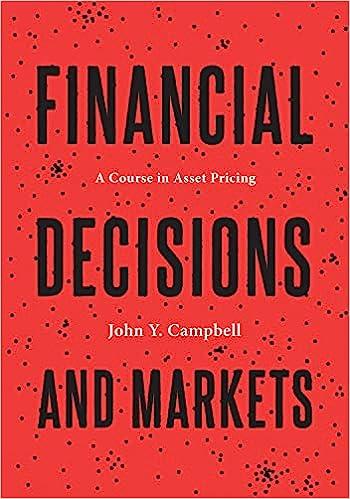In this exercise, you are asked to explore some classic issues from the empirical literature on stock
Question:
In this exercise, you are asked to explore some classic issues from the empirical literature on stock market returns. The data for this question can be found in an Excel spreadsheet on the textbook website. \({ }^{14}\) To perform the analysis, we suggest using MATLAB or similar software that allows you to write flexible code.
We consider six assets: four Fama-French portfolios (small-low, small-high, big-low, big-high), the market portfolio, and the 30-day Treasury bill. The four Fama-French portfolios are the corners of the \(2 \times 3\) size/value portfolios found on Kenneth French's website. The market portfolio is the value-weighted portfolio of stocks listed on NYSE, AMEX, and NASDAQ. The data set runs from July 1926 to June 2016.
(a) Download the data from the textbook website. Do the exercises described in parts (i), (ii), and (iii) for the whole sample and also for two subsamples: 7/26-12/63 and \(1 / 64-6 / 16\).
(i) Estimate the vector of sample mean excess returns and the covariance matrix of excess returns, for each of the samples. Use these estimates to compute two ex-post mean-variance efficient sets: one for portfolios not including the riskless asset and one including the riskless asset. Plot the two sets on a graph with the standard deviation of excess returns on the horizontal axis and the mean excess return on the vertical axis, and indicate where each of the four FamaFrench portfolios and the market portfolio lie. Calculate the Sharpe ratios of the tangency portfolio and the market portfolio.
(ii) Plot expected return against beta for each of the portfolios. Calculate alphas and discuss your results.
(iii) Test the hypothesis that the market portfolio is mean-variance efficient by calculating a Gibbons-Ross-Shanken test statistic. Interpret your results.
(b) In recent years there has been concern that the publicity given to value investing and the creation of quantitative investment strategies may alter the properties of value returns. One variant of this concern is that the excess return to value may disappear permanently as quantitative investors bid up the price of value stocks to efficient levels. Another variant is that the excess return to value may become less stable as capital flows in and out of value stocks in response to shifting sentiment of end investors about quantitative value strategies. Some have even argued that such shifting sentiment may cause the excess return to value to display a pattern of short-term positive autocorrelation ("style momentum") and longer-term negative autocorrelation ("style reversal").
(i) Plot a one-year moving average of the excess return to small value stocks over small growth stocks (small-high minus small-low, or "small HML") over the period 1/64-6/16. Compare the behavior of the plot in two subsamples: \(1 / 64-12 / 93\) and \(1 / 94-6 / 16\).
(ii) Calculate the mean, standard deviation, and Sharpe ratio of the excess return on the market portfolio over the Treasury bill, and the return on small HML, for each of the two subsamples.
(iii) Aggregate the small HML return to the quarterly data frequency and plot its autocorrelation function out to 12 quarters (3 years) in each of the two subsamples.
(iv) What do your results suggest about the changing behavior of value returns in recent years? Do they support any of the concerns described above?
Step by Step Answer:

Financial Decisions And Markets A Course In Asset Pricing
ISBN: 9780691160801
1st Edition
Authors: John Y. Campbell




